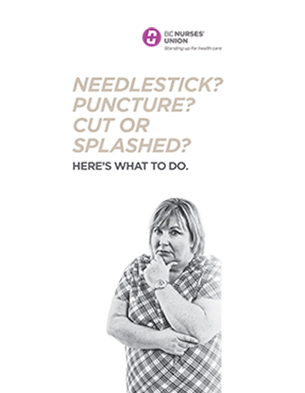 Workplace Exposures
Workplace Exposures

Needlestick? Puncture? Cut or Splashed?
Workplace exposures occur when members work with or around chemical, biological, and physical hazards that can lead to an acute or chronic illness, and even death.
Nurses and other frontline health care workers encounter numerous chemical, physical, and biological hazards in their work - some having consequences that may not become evident for decades, including drugs, cleaners, bacteria, needlestick injuries, noise, and ionizing radiation.
Exposure Control Plans
In accordance with OH&S regulations, where there is a risk of exposure to a chemical, biological or physical hazard, the employer must eliminate the exposure, or control it to below harmful levels, and implement exposure control plans (ECPs).
ECPs are designed to document risks, and outline the measures that must be taken to eliminate or minimize them. ECPs also include education, written procedures, worksite-specific hygiene facilities, and health monitoring. The plans should be made in consultation with the local JOHS committee.
BCNU's OH&S department works with JOHS committees to ensure employers and members are aware of the risks and preventative measures, for workplace exposures.
For further information about workplace exposures such as exposure control plans for chemical, biological or physical hazards, please contact healthandsafety@bcnu.org.
Resources
- Assisting a member following a needlestick - hints and tips for stewards and JOHSC representatives
- Occupational Health and Safety Agency for Health Care in BC (OHSAH)
- Point-of-Care Risk Assessment Card
- WorkSafeBC:
Controlling Exposure: Protecting Workers From Infectious Disease
Best Practices for the Safe Handling of Hazardous Drugs
Part 5 Chemical Agents and Biological Agents
Part 6 Substance Specific Requirements

